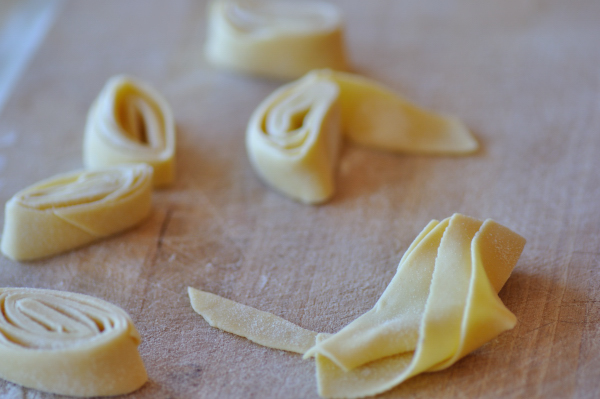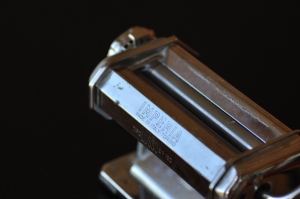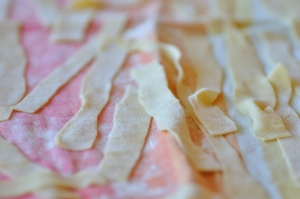And after taking a stroll around the world, foodwise (I saw this lovely old movie a few nights ago), here I am, back home: back to Italy, with pasta.
Like most Italian people who cook, I often make my own. Fresh pasta is a completely different product from ‘regular’ dried durum wheat pasta, the one sold in every supermarket; and it is infinitely better than store-bought fresh pasta, unless of course you have a good pastificio artigianale down the road. For these reasons, if you have never eaten it, you really should give this (or any other recipe) a try. Once you learn the basics, it is easy to make: I have tested this on a few friends, who asked me to teach them how to make pasta: they could not believe the sumptuous dish of pappardelle al ragù we produced after a mere couple of hours work.
(It can take less than that, with some experience; it will take more than that, if you make ragù without a pressure cooker).
Pasta does not require hi tech equipment, but it does require equipment. You can work and spread the dough entirely by hand or using machines, but either way, you are going to need somewhere to put ready pasta: a clean, flat, non sticky surface that you can possibly carry around to allow the pasta to reach its cooking pot. In most modern, space limited kitchen I have worked with, I have found this to be the greatest challenge. This is also why I rarely prepare home-made pasta when inviting friends over for dinner: space limitations begin to count if you make pasta for more than four-five people. In several traditional Italian houses there is a large, lightweight spianatoia: a thin wooden board, sturdy enough to hold some weight, that can be stored in some corner when not in use, and is then arranged on top of the table, as an extension, to accommodate pasta and carry it around. Another popular solution is to use multi-tiered trolleys covered with trays or kitchen towels.
For some reason I have never managed to implement any of these, and have been stuck most time with make-do solutions involving cutting boards and kitchen cloths shuffled around the apartment on every available surface, ready to be chased by the cats. With my parents we even dismantled the doors of a wardrobe and used them to carry pasta around. It was an emergency situation.
Anyway, you’ll have to display some creative flare, and make do with what you have at hand, if you want to prepare a lot of pasta. This is a quintessentially Italian art, both in spirit and in practice. Indeed there exist Italian mamme e nonne (occasionally even some grandfather, why not) who think nothing of making pasta for ten people every Sunday lunch among three or four other courses, of course after going to Mass.
Personally, I never make pasta for more than four people, little lazy expat that I am. Most of the time I make it for two. This does not take long. I come from the Northern part of Italy, so the huge variety of hand-made tiny pasta shapes is kind of exotic to me. I am studying with every grandmother I meet, but I need more dedication. For my background, pasta is either filled ravioli and tortellini, or tagliatelle, made with soft wheat flour and a lot of eggs to guarantee some bite. I tend to move away from this and more and more include durum wheat and cut down on the eggs: the flavour of durum wheat flour is so appealing. I knead my dough by hand (actually, mostly by fork) since I don’t have a food processor, but feel free to use it if you have one. To roll the dough, I have two rolling pins I use sometimes, but I do have a pasta maker I use regularly:
it was my grandmother’s (not this one, the other one, who died when I was a child), who did not care much about cooking, anyway, so although I think this pasta maker was produced in the seventies, it was basically new when I started to use it, more than thirty years later. It is not a top quality one, despite the ‘tipo lusso’ engraved on it: actually a few years of regular usage are already taking their toll on it. I have used a variety of filled bottles more or less effectively in place of missing rolling pins, but while this can work for pastry, don’t try that for pasta, or you are going to hate yourself and the pasta.
I make a variety of pasta doughs that are quite my own recipes. My signature one is made with black cuttlefish ink – but there is not a black cuttlefish in sight at least for two thousand kilometers. The one I am sharing with you today is a recent addiction to my repertoire. To my surprise, it is very easy to find in Germany ‘dinkel mehl’, spelt flour, akin to the Italian farro. Spelt flour has something earthy on it, but is subtle enough not to produce health food taste, if you know what I mean. Actually this flour has grown to be my go-to flour when I don’t need much gluten. It always works and it always adds a little something. I pair it here with semola and eggs for bite. The result is a golden, flavourful pasta that needs a runny, greasy sauce, and will pay you back with an interesting bite and a deep flavour. Try dressing it with either version of ragù, or with an artichoke creamy sauce. As far as shape is concerned, tagliatelle are always a good option, but with many sauces I like to keep a rustic look and cut it in large and short pappardelle. They are also easier to eat for non-adept pasta eaters. Since this is an original recipe of mine, I am sending this to Creative Concoctions, a new event invented by the always creative Ivy. I’m looking forward to the upcoming roundup – I’m sure there will be a lot of interesting ideas.
For two:
100 gr durum wheat flour (semola di grano duro)
100 gr spelt flour
1 medium egg
about 5 tablespoon water
1/4 teaspoon salt
Method:
Mix well the two flours . I find sifting non necessary, but you may want to do it if your flours are very lumpy. Put them on a very large bowl so that they look like a little volcano. Make a hole in the center and break the egg into it. Add the salt and whisk the egg with a fork until roughly uniform. Add in two tablespoons of water, at room temperature. Keep mixing with a fork and start incorporating some of the flour from the walls. Mix more and more until all the egg is absorbed by the flour. Put down the fork and start kneading by hand. You may need to add more water, a tablespoon at a time, to allow the dough to come together. Bear in mind that the resulting dough needs to be very hard, so try to add the minimum amount you need to have a uniform, but non sticky, dough. When the dough is uniform enough to make a ball of it, take it off the bowl (if you want to) and work it by kneading it for a few minutes until perfectly uniform and elastic. With a little experience you can do also this on the bowl, reducing washing. Wrap in cling film and let rest for about half an hour. Rest is important to make the dough lose a little elasticity; it is crucial if you want to roll the dough by hand, but optional if you use a pasta machine.
If you roll the dough by hand: use a large surface with semola, and roll the dough uniformly using a rolling-pin. Make sure the dough does not stick. When it is about 1.5 mm thick (you can go even thinner if you like, or make it thicker for more bite), cut it into large strips, then roll them and cut them into the desired shape.
If you use a pasta machine: pass the dough in the largest width of the pasta maker for a few times, until the air bubbles in the pasta make it pop. This is a sign that the pasta has the right elasticity to be rolled thinly. Divide the dough in about three parts, pass each in an intermediate gauge then in the second or third smaller one, depending on the desired thickness. Dust with a bit of semola, cut into 25 cm long pieces, roll them and cut into slices, about 2 cm high.
Unfold the slices and allow them to dry on a kitchen towel spread with semola for a while (make up to a day ahead). When ready to serve, cook the pasta for 3 minutes in plenty of salted boiling water. Drain and dress. Serve immediately.





